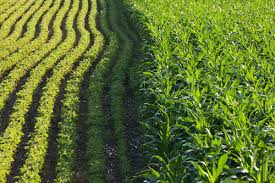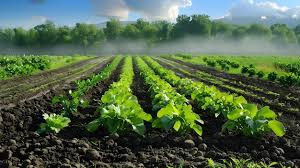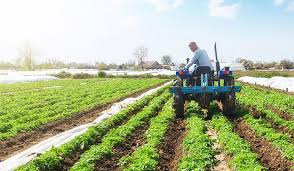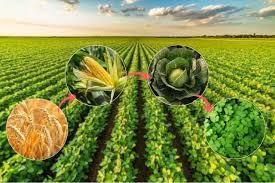Crop rotation systems are essential practices in sustainable agriculture, designed to enhance soil health, improve crop yields, and reduce the dependency on chemical inputs.
By systematically alternating different crops on the same land over time, farmers can create a more balanced ecosystem that promotes biodiversity and minimizes the risk of pest and disease outbreaks.
This method has been employed for centuries and is rooted in traditional farming practices that recognize the interdependence of crops and soil.
One of the primary benefits of crop rotation is the improvement of soil fertility. Different crops have varying nutrient requirements and growth patterns.
For instance, legumes, such as beans and peas, are known for their ability to fix nitrogen in the soil, enriching it for subsequent crops.
When rotated with nitrogen-demanding crops like corn or wheat, the overall nutrient balance of the soil is improved, leading to healthier plants and higher yields.
This natural fertilization process reduces the need for synthetic fertilizers, which can be harmful to the environment and costly for farmers.
In addition to enhancing soil fertility, crop rotation plays a significant role in pest and weed management. Many pests and diseases are crop-specific, meaning that they thrive when the same crop is planted repeatedly. By rotating crops, farmers can disrupt the life cycles of these pests and reduce their populations.
For example, if a farmer plants corn one year and then rotates to soybeans the next, pests that specifically target corn will have a more challenging time finding a suitable host, leading to a decrease in infestation levels.
Moreover, crop rotation can help in managing weeds by changing the competition dynamics in the field. Certain crops may outcompete weeds more effectively than others, leading to a natural reduction in weed pressure.
Another advantage of crop rotation systems is the enhancement of biodiversity. Diverse cropping systems promote a variety of beneficial organisms in the soil, such as earthworms and microorganisms, which contribute to a more resilient agricultural ecosystem.
This biodiversity can improve soil structure, enhance nutrient cycling, and promote better water retention, ultimately leading to more sustainable farming practices.
Furthermore, by incorporating cover crops or intercrops into the rotation, farmers can further enhance soil health, prevent erosion, and suppress weed growth.
In the context of climate change, crop rotation systems can also provide farmers with greater resilience against extreme weather events.
Diverse cropping systems can better withstand droughts, floods, and temperature fluctuations. For instance, deep-rooted crops can help improve soil structure and water infiltration, making the land more adaptable to changing climate conditions.
Crop rotation systems are a fundamental aspect of sustainable agriculture that fosters healthy ecosystems, enhances soil fertility, and promotes agricultural resilience.
By implementing these practices, farmers can work toward achieving long-term sustainability in food production while reducing their environmental impact.
As agriculture continues to evolve in response to global challenges, the adoption of crop rotation will remain a key strategy in promoting sustainable farming practices that benefit both farmers and the environment.
Understanding Crop Rotation and Its Importance

1. Definition of Crop Rotation: Crop rotation involves the practice of growing different types of crops in the same area across a sequence of seasons.
2. Historical Context: This agricultural method has been used for centuries to maintain soil fertility and manage pests and diseases.
3. Importance in Agriculture: Crop rotation helps to break pest and disease cycles, improves soil structure, enhances nutrient availability, and promotes biodiversity.
4. Soil Health Improvement: Rotating crops fosters a balanced nutrient profile and improves soil organic matter, leading to healthier soil ecosystems.
Benefits of Crop Rotation in Sustainable Farming
1. Pest and Disease Management: Rotating crops disrupts the life cycles of pests and pathogens, reducing their prevalence and minimizing the need for chemical pesticides.
2. Nutrient Management: Different crops have varying nutrient requirements. By rotating crops, farmers can optimize nutrient use and prevent nutrient depletion.
3. Improved Soil Fertility: Leguminous crops, such as peas and beans, can fix atmospheric nitrogen, enhancing soil fertility when rotated with non-leguminous crops.
4. Erosion Control: Diverse cropping systems improve soil structure and cover, reducing soil erosion and maintaining soil health.
5. Weed Suppression: Changing crops can help disrupt weed life cycles and reduce weed populations, leading to less competition for resources.
6. Increased Yields: Crop rotation can lead to higher and more stable yields over time, as the soil health and ecosystem balance improve.
Types of Crop Rotation Systems
1. Simple Crop Rotation: Involves rotating two or more crops in a sequence, often with a legume followed by a cereal crop.
2. Multiple Crop Rotation: This system includes a more extensive variety of crops over several seasons, promoting biodiversity and soil health.
3. Sequential Cropping: Different crops are planted in a single growing season, allowing for maximum use of available land and resources.
4. Cover Crop Rotation: Integrating cover crops in the rotation helps improve soil structure, prevent erosion, and enhance organic matter content.
5. Crop-Livestock Rotation: Incorporating livestock into the crop rotation system allows for nutrient recycling through manure and improves pest management.
Read Also: Grapefruit Leaves: Economic Importance, Uses and By-Products
Key Principles of Effective Crop Rotation

1. Diversity of Crops: Utilize a wide variety of crops to promote biodiversity and minimize the risk of pest and disease outbreaks.
2. Crop Families: Rotate crops from different botanical families to prevent the buildup of specific pests and diseases associated with certain crops.
3. Nutrient Needs and Benefits: Consider the nutrient needs and contributions of each crop to optimize soil fertility and balance nutrient uptake.
4. Timing and Seasons: Plan rotations based on the growing seasons and climatic conditions to maximize growth potential and minimize risks.
5. Soil Health Monitoring: Regularly assess soil health to adjust crop rotations based on changes in soil fertility and structure.
6. Flexibility and Adaptation: Be prepared to modify crop rotation plans based on changing environmental conditions, market demands, and pest pressures.
Planning Your Crop Rotation Schedule
1. Assess Your Land: Evaluate your soil type, previous crop history, and specific growing conditions to inform your crop rotation plan.
2. Identify Crop Requirements: Determine the nutrient needs, growth cycles, and environmental conditions of the crops you wish to grow.
3. Create a Crop Calendar: Develop a calendar outlining when each crop will be planted and harvested, considering seasonal variations and crop growth durations.
4. Sequence Crops: Plan the order of crops based on their nutrient needs, growth habits, and pest management strategies, ensuring that nutrient-depleting crops are followed by those that replenish the soil.
5. Include Cover Crops: Incorporate cover crops in the rotation schedule to enhance soil fertility, prevent erosion, and improve soil structure.
6. Monitor and Adjust: Regularly review the performance of your crop rotation plan, making adjustments as necessary based on yields, soil health, and pest pressures.
Incorporating Legumes in Crop Rotation
1. Nitrogen Fixation: Legumes have the unique ability to fix atmospheric nitrogen, enriching the soil and benefiting subsequent crops in the rotation.
2. Improve Soil Structure: Legumes contribute organic matter to the soil, enhancing its structure and moisture retention capabilities.
3. Reduce Fertilizer Needs: By incorporating legumes, farmers can reduce the need for synthetic nitrogen fertilizers, leading to cost savings and environmental benefits.
4. Pest Suppression: Legumes can help suppress specific pests and diseases, reducing reliance on chemical pest control measures.
5. Timing Considerations: Plan the timing of legume planting to coincide with the growing seasons of main crops, maximizing their beneficial effects on soil fertility.
6. Rotation Examples: Common rotations may include planting legumes like soybeans or peas followed by cereals such as wheat or corn.
Read Also: 15 Medicinal Health Benefits Of Calea ternifolia (Dream Herb)
Crop Rotation and Soil Health

1. Enhanced Nutrient Availability: Diverse cropping systems improve nutrient cycling and availability, promoting healthier plant growth.
2. Soil Microbial Diversity: Rotating crops fosters a diverse microbial community, essential for soil health and nutrient breakdown.
3. Prevention of Soil Degradation: Regularly rotating crops helps prevent soil depletion, erosion, and compaction, maintaining soil quality over time.
4. Organic Matter Improvement: Different crops contribute various organic materials to the soil, improving overall soil fertility and structure.
5. Soil Moisture Retention: Rotating crops with different root structures enhances water infiltration and retention in the soil.
6. Long-Term Productivity: Healthy soils support sustainable farming practices, ensuring long-term agricultural productivity and resilience.
Pest and Disease Management Through Crop Rotation
1. Disruption of Pest Life Cycles: Rotating crops interrupts the life cycles of pests and diseases, reducing their populations and impacts.
2. Reduced Dependency on Pesticides: Effective crop rotation minimizes the need for chemical pesticides, promoting a more sustainable approach to pest management.
3. Variety Selection: Choose crop varieties known to be resistant to specific pests and diseases prevalent in previous crops.
4. Monitoring and Assessment: Regularly monitor fields for pest populations and crop health, allowing for timely interventions when necessary.
5. Integration with Other Practices: Combine crop rotation with other pest management strategies, such as biological control or cultural practices, for enhanced effectiveness.
6. Long-Term Strategy: Develop a long-term pest and disease management plan based on crop rotation, ensuring a sustainable approach to farming.
Crop Rotation’s Role in Enhancing Biodiversity
1. Increased Plant Diversity: Crop rotation introduces a variety of plant species in a given area, promoting a diverse ecosystem that supports beneficial insects and wildlife.
2. Habitat for Beneficial Organisms: Diverse crops provide habitats for beneficial organisms, such as pollinators and natural pest predators, enhancing ecological balance.
3. Nutrient Cycling: Different crops have varying nutrient requirements and root structures, which helps maintain soil fertility and health, promoting microbial diversity in the soil.
4. Disease Resistance: Rotating crops can break the life cycles of specific pests and diseases, reducing their prevalence and promoting a healthier ecosystem.
5. Soil Microbial Diversity: Crop rotation encourages a diverse soil microbial community, which plays a crucial role in nutrient cycling, soil structure, and plant health.
6. Resilience to Environmental Changes: Biodiverse systems are more resilient to environmental stresses, such as climate change, as they can better withstand fluctuations in weather and pests.
Economic Advantages of Crop Rotation Systems
1. Increased Crop Yields: By improving soil health and fertility, crop rotation can lead to higher and more consistent crop yields over time.
2. Reduced Input Costs: Crop rotation decreases the reliance on chemical fertilizers and pesticides, lowering overall production costs for farmers.
3. Improved Soil Health: Healthier soils result in reduced erosion and degradation, leading to sustainable land use and potential long-term economic benefits.
4. Enhanced Market Opportunities: Diverse crop production can open up new markets and income streams, allowing farmers to cater to different consumer preferences.
5. Risk Management: Crop rotation spreads financial risk by diversifying income sources, reducing the impact of market fluctuations or crop failures.
6. Access to Subsidies and Grants: Some agricultural programs offer financial incentives for sustainable practices, including crop rotation, providing economic support to farmers.
Challenges in Implementing Crop Rotation
1. Knowledge and Experience: Farmers may lack the necessary knowledge or experience to design and implement effective crop rotation systems tailored to their specific conditions.
2. Market Demand: Limited market demand for certain crops may discourage farmers from rotating, as they may prefer to grow cash crops with guaranteed sales.
3. Labor and Management: Crop rotation can require more labor and management resources, which may be challenging for smaller farms with limited capacity.
4. Soil Type Limitations: Not all soil types are suitable for every crop, making it essential to match crops with the right soil conditions, which can complicate planning.
5. Pest and Disease Risks: While crop rotation can help manage pests, introducing new crops can also bring unfamiliar pests and diseases into the system.
6. Initial Transition Challenges: Transitioning from conventional monoculture practices to a diversified rotation system may involve initial challenges, including changes in farming habits and equipment needs.
Do you have any questions, suggestions, or contributions? If so, please feel free to use the comment box below to share your thoughts. We also encourage you to kindly share this information with others who might benefit from it. Since we can’t reach everyone at once, we truly appreciate your help in spreading the word. Thank you so much for your support and for sharing!

